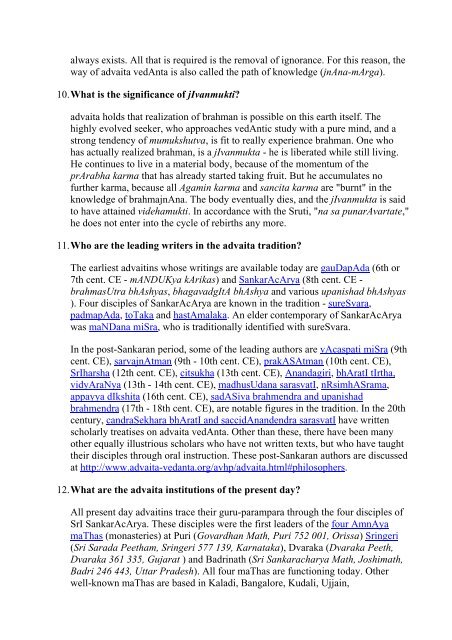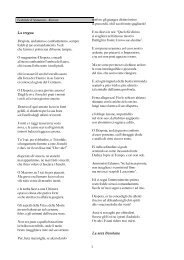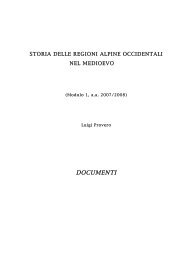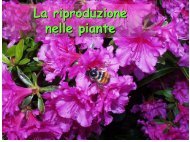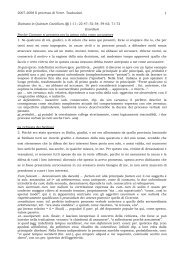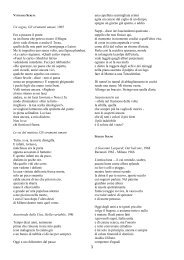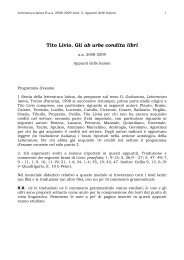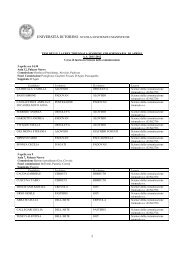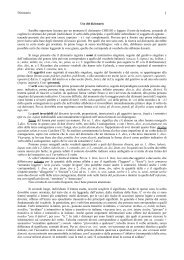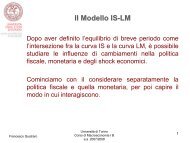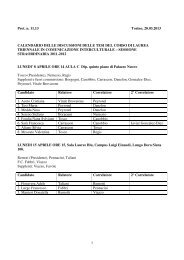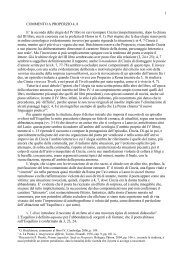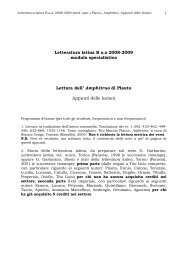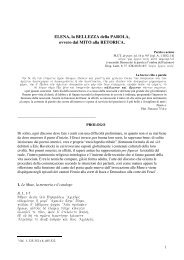ajAti vAda
ajAti vAda
ajAti vAda
Create successful ePaper yourself
Turn your PDF publications into a flip-book with our unique Google optimized e-Paper software.
always exists. All that is required is the removal of ignorance. For this reason, the<br />
way of advaita vedAnta is also called the path of knowledge (jnAna-mArga).<br />
10. What is the significance of jIvanmukti?<br />
advaita holds that realization of brahman is possible on this earth itself. The<br />
highly evolved seeker, who approaches vedAntic study with a pure mind, and a<br />
strong tendency of mumukshutva, is fit to really experience brahman. One who<br />
has actually realized brahman, is a jIvanmukta - he is liberated while still living.<br />
He continues to live in a material body, because of the momentum of the<br />
prArabha karma that has already started taking fruit. But he accumulates no<br />
further karma, because all Agamin karma and sancita karma are "burnt" in the<br />
knowledge of brahmajnAna. The body eventually dies, and the jIvanmukta is said<br />
to have attained videhamukti. In accordance with the Sruti, "na sa punarAvartate,"<br />
he does not enter into the cycle of rebirths any more.<br />
11. Who are the leading writers in the advaita tradition?<br />
The earliest advaitins whose writings are available today are gauDapAda (6th or<br />
7th cent. CE - mANDUKya kArikas) and SankarAcArya (8th cent. CE -<br />
brahmasUtra bhAshyas, bhagavadgItA bhAshya and various upanishad bhAshyas<br />
). Four disciples of SankarAcArya are known in the tradition - sureSvara,<br />
padmapAda, toTaka and hastAmalaka. An elder contemporary of SankarAcArya<br />
was maNDana miSra, who is traditionally identified with sureSvara.<br />
In the post-Sankaran period, some of the leading authors are vAcaspati miSra (9th<br />
cent. CE), sarvajnAtman (9th - 10th cent. CE), prakASAtman (10th cent. CE),<br />
SrIharsha (12th cent. CE), citsukha (13th cent. CE), Anandagiri, bhAratI tIrtha,<br />
vidyAraNya (13th - 14th cent. CE), madhusUdana sarasvatI, nRsimhASrama,<br />
appayya dIkshita (16th cent. CE), sadASiva brahmendra and upanishad<br />
brahmendra (17th - 18th cent. CE), are notable figures in the tradition. In the 20th<br />
century, candraSekhara bhAratI and saccidAnandendra sarasvatI have written<br />
scholarly treatises on advaita vedAnta. Other than these, there have been many<br />
other equally illustrious scholars who have not written texts, but who have taught<br />
their disciples through oral instruction. These post-Sankaran authors are discussed<br />
at http://www.advaita-vedanta.org/avhp/advaita.html#philosophers.<br />
12. What are the advaita institutions of the present day?<br />
All present day advaitins trace their guru-parampara through the four disciples of<br />
SrI SankarAcArya. These disciples were the first leaders of the four AmnAya<br />
maThas (monasteries) at Puri (Govardhan Math, Puri 752 001, Orissa) Sringeri<br />
(Sri Sarada Peetham, Sringeri 577 139, Karnataka), Dvaraka (Dvaraka Peeth,<br />
Dvaraka 361 335, Gujarat ) and Badrinath (Sri Sankaracharya Math, Joshimath,<br />
Badri 246 443, Uttar Pradesh). All four maThas are functioning today. Other<br />
well-known maThas are based in Kaladi, Bangalore, Kudali, Ujjain,


